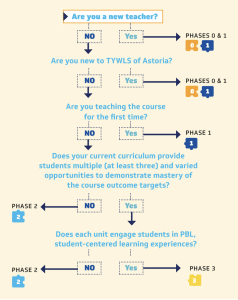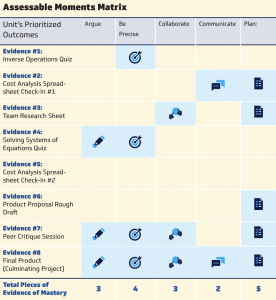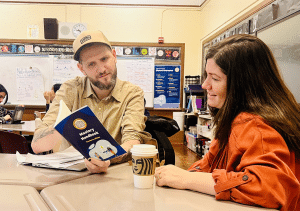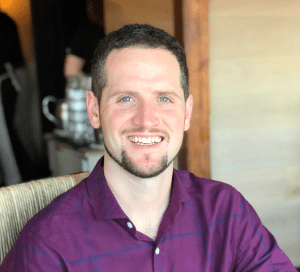Beyond Packaging: Manifesting Mastery-Based Learning in the Classroom at TYWLS of Astoria
CompetencyWorks Blog
Shortly after its founding in 2006, The Young Women’s Leadership School (TYWLS) of Astoria shifted to a mastery-based learning model to create a more equitable and transparent grading system. In addition to increasing clarity around grading, we believed a mastery approach, which we use synonymously with competency-based education (CBE), had the potential to support the creation of learner-centered classrooms. We envisioned learning experiences where transparency about grades and shared expectations would foster student agency and, in turn, help build a school students felt was made for them.
The operative term here is “potential,” as adopting a mastery-based learning model doesn’t guarantee an immediate transition to student-centered learning and equity. Successful school-wide implementation is a gradual process that unfolds over time requiring sustained effort.

The development of the Teacher Mastery Handbook, as discussed in the first installment of this series, was fueled by our commitment to actualizing the foundational principles that initially guided our school toward CBE.
As we endeavor to bridge theory with practice, we remain vigilant about what I term the “packaging of CBE.” This refers to instances where schools implement CBE systems and structures, giving the appearance of a competency-based education approach, while classroom practices may still align more with traditional methods.
Given these considerations, it’s unsurprising that the largest section of our Teacher Mastery Handbook is dedicated to mastery implementation at the classroom level.
As a strategic response to the dynamic nature of mastery-based learning, we developed a systematic approach to mastery implementation with four phases. This approach provides realistic benchmarks for teachers to meet them where they are in their professional journey. The phases also assist administrators and instructional coaches in offering targeted support and establishing realistic expectations for progress evaluation.
Identifying an Entry Point to Mastery-Based Learning
The Mastery Implementation at the Classroom Level section opens with a self-assessment tool consisting of a series of questions. Teachers’ responses will guide them to the corresponding phase and page in the handbook.
 Teachers in Phase 0: Introduction begin by deeply studying and understanding mastery-based learning and the TYWLS shared outcomes and departmental outcome targets. This exploration typically starts before school commences with the guided support of a facilitator or mentor teacher.
Teachers in Phase 0: Introduction begin by deeply studying and understanding mastery-based learning and the TYWLS shared outcomes and departmental outcome targets. This exploration typically starts before school commences with the guided support of a facilitator or mentor teacher.
Teachers in Phase 0 will very quickly find themselves in Phase 1: Immersion, immersing themselves in established school-wide, mastery-based learning practices. This does not signal moving on from or mastery of phase 0. While phased, this is a recursive process. Even teachers in Phase 2 or 3 continue to engage in the mindset work and develop their understanding of mastery-based education.
Instead of designing a new curriculum, we ask that teachers in Phase 1 utilize previously designed and/or vetted curriculum. That way they are able to experience the components of a rigorous curriculum created with “mastery-in-mind” that they can replicate in the future.
Teachers in Phase 2: Implementation intentionally map out their curriculum, plan project-based learning (PBL) units, and design daily lessons to ensure students receive multiple and varied opportunities to demonstrate mastery of the course outcome targets. Their curriculum is intentional, responsive, and student-centered. They adjust lessons based on individual and group trends in student mastery and create opportunities for students to play a greater role in assessing their work and driving feedback conversations. 
To support teachers in this phase, the handbook includes a step-by-step guide on designing or co-designing units with what we call “mastery-in-mind” to build a curriculum that seamlessly aligns with the principles of mastery-based learning.
A crucial step in this process involves identifying (in advance) the ‘assessable moments’ or opportunities within a unit or project for students to practice the prioritized outcome targets. These specific moments or checkpoints along the way toward completion of the performance tasks or culminating project provide students with an opportunity to receive feedback and monitor their progress toward mastery. The handbook recommends that teachers create an ‘Assessable Moments Matrix,’ a structured tool to systematically plan and document these critical junctures. This matrix offers a comprehensive overview and becomes an resource for fostering a continuous cycle of assessment, feedback, and improvement throughout the learning journey.
Building on this structured approach to assessment, we firmly believe that “without personalization,” competency-based education “cannot guarantee that students will receive the instruction and support they need to learn.” In Phase 3: Innovation, teachers extend the design process outlined in Phase 2, actively seeking additional ways to engage students in the collaborative creation of units and projects. They emphasize personalized learning pathways to provide a range of opportunities for students to demonstrate and generate evidence of mastery. 
Providing Concrete, Practical Examples and Room to Grow
When we shared an early draft of these phases with our colleagues, one teacher emphasized “personalized learning pathways” and “student input” and observed that, without specific examples, these terms seemed somewhat abstract, like “magic tricks.” Several pages of the handbook are therefore dedicated to illustrating how to personalize or individualize learning at the curriculum, unit, and lesson levels. For example:
- At the curriculum level: Students are invited to provide meaningful, ongoing input about various aspects of pedagogy, curriculum, learner roles, and classroom culture
- At the unit level: Elements of self-pacing are embedded to allow students to complete tasks or stages of a project at their own pace.
- At the lesson level: Differentiated tasks for students based on individual needs, interests, perspectives, and critical lenses
While our framework outlines four distinct phases, the journey through competency-based education is dynamic and ongoing. It’s important to recognize that teachers may find themselves in one phase for teaching one class and in a different phase for another. Moreover, the iterative nature of this process means that even when teachers reach Phase 3, they continuously invent, adapt, and improve new practices to respond to the demands of a changing world, reaching students in more effective and exciting ways.
It is not accidental that we chose to begin this section with a timeline chronicling our school’s journey in adopting mastery-based learning. This chronological overview, featuring crucial milestones, successes, and challenges, not only offers historical context and traces the evolution of our approach, but also underscores the importance of persistence, continuous improvement, and strategic decision-making in the realm of educational transformation. It extends an invitation to new teachers and those new to our school to become integral participants in this ongoing journey. 
Learn More
- There’s A Google Doc For That! One School’s Journey Creating a Comprehensive “Mastery Handbook”
- The TYWLS Mastery Handbook: Teachers Edition
- CBE Starter Pack 6: Equity Strategies Drive Culture, Structures, and Pedagogy
 Greg Zimdahl is a middle school humanities teacher at TYWLS in Astoria, Queens, where he began teaching 16 years ago after graduating from NYU’s Steinhardt School of Education with a Bachelor of Science in Social Studies Education. In 2011, Greg earned his Master of Arts in African American Studies from the acclaimed Institute for Research in African American Studies at Columbia University. In addition to teaching, Greg currently serves as an Instructional Coach and oversees the school’s Mastery Team, including a Youth Ambassador Program. He collaborated with the founding teacher team to design and implement the school’s nationally acclaimed full school competency-based system. Two summers ago, Greg has spearheaded the design of several essential structures and systems at TYWLS of Astoria, such as the new Teacher Residency Program, Intensives (a ten-day, school-wide event engaging students in project-based learning with a culminating public expo), and ACT Advisory Camp TYWLS (a two-day immersive project at the start of the academic year aimed at fostering community and setting norms).
Greg Zimdahl is a middle school humanities teacher at TYWLS in Astoria, Queens, where he began teaching 16 years ago after graduating from NYU’s Steinhardt School of Education with a Bachelor of Science in Social Studies Education. In 2011, Greg earned his Master of Arts in African American Studies from the acclaimed Institute for Research in African American Studies at Columbia University. In addition to teaching, Greg currently serves as an Instructional Coach and oversees the school’s Mastery Team, including a Youth Ambassador Program. He collaborated with the founding teacher team to design and implement the school’s nationally acclaimed full school competency-based system. Two summers ago, Greg has spearheaded the design of several essential structures and systems at TYWLS of Astoria, such as the new Teacher Residency Program, Intensives (a ten-day, school-wide event engaging students in project-based learning with a culminating public expo), and ACT Advisory Camp TYWLS (a two-day immersive project at the start of the academic year aimed at fostering community and setting norms).